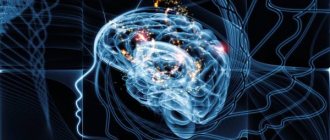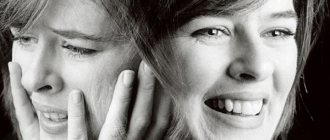Dyscalculia is the inability to operate with mathematical categories, the inability to understand the essence of arithmetic operations, the concepts of “number”, “sum”, “triangle” and the like. As a rule, this disorder appears in children of preschool and primary school age, but it can also occur in adults. Dyscalculia is difficult to diagnose for a non-specialist, so children with this pathology often end up in specialized classes for schoolchildren with mental development disorders.
Approximately 10% of schoolchildren suffer from some form of dyscalculia. Not all parents know that with timely diagnosis even in preschool age, effective measures can be taken to prevent this pathology and make it easier for the child to master the school curriculum.
If a child suffers from manifestations of dyscalculia, he experiences a negative attitude towards the “exact sciences”. Chronic underachievement can also affect mastery of humanities subjects, as well as cause a student’s low social status. He does not have good relationships with his peers, and teachers and parents often put unjustifiably strong pressure on him because of his perceived laziness and lack of diligence. In the future, such children experience difficulties with choosing a profession and self-realization.
general information
Disturbances in the development of mathematical operations and abstract concepts are quite common - in 5-6% of schoolchildren. In most cases, pathology is not diagnosed, as it is perceived by parents in the form of character traits and a penchant for humanitarian subjects.
At what age can we talk about dyscalculia?
Psychologists recommend making a diagnosis no earlier than 5-6 years. This age corresponds to the preschool period, when learning and the formation of basic skills and knowledge in working with abstract symbols and actions begin.
It is important to distinguish between the concepts of acalculia and dyscalculia. The main differences between them are that with dyscalculia the child has a partial impairment in mastering arithmetic, while with acalculia the ability to count is completely absent. The latter violation is observed in cases of serious brain damage or pedagogical neglect in upbringing.
DYSCALCULIA IS
Dyscalculia is the lack of ability to solve arithmetic problems.
Often a consequence of mental disorders. The child does not understand numerical symbols, how numbers can be compared (for example, by size), perform the functions of subtraction, addition, division, multiplication; there is no logic for arithmetic operations.
Children of preschool age begin to distinguish geometric shapes and sizes of objects later than their peers. And dyscalculia in younger schoolchildren manifests itself in a delay in learning, which involves the use of numbers for counting calculations.
Reasons for the development of disorders
Depending on the etiological factor, the disorder is divided into three types: genetic, organic or psychogenic. Often, these forms are combined with each other. Effective treatment without identifying the immediate cause is impossible. Doctors note the following features of types of dyscalculia:
- In case of psychogenic disorders, a negative attitude of the child towards arithmetic is revealed. This may be due to pressure from parents during the learning process, harsh punishments for incorrect answers, and conflict between the teacher or parent and student.
- Genetic predisposition is identified in schoolchildren whose parents also experienced difficulties in mastering mathematics. The direct gene responsible for the account has not been found, however, experts do not deny the genetic nature of the disorder in some patients.
- An organic disease is associated with a disruption in the structure or functioning of areas of the brain that provide processes for perceiving and analyzing information. Such changes can occur against the background of birth injuries, negative effects on the fetus during pregnancy (infections and bad habits in the mother), traumatic brain injuries and neuroinfections. In adult patients, an organic type of dyscalculia is noted.
With any type of disorder, neuronal dysfunction is observed in the parietal cortex of the cerebral hemispheres. First of all, disturbances affect the intraparietal sulcus, where the center for the perception of abstract symbols and counting is located. A child with the disease experiences a decrease in the ability to cognition and process symbolic information. In addition, the inability to perform mathematical operations may be associated with increased distractibility, insufficient processing speed of incoming data, and impaired attention.
What disorders is it associated with?
Dyscalculia is an independent disease, but can often be combined with other disorders. Pathologies that may accompany it have a similar genesis and are caused by congenital pathologies of brain development, mental retardation, and psychological health disorders. A child with dyscalculia may also experience:
- dyslexia – impaired ability to read and write;
- attention deficit disorder – impaired concentration, uncontrolled impulsiveness, hyperactivity;
- Dysgraphia is the inability to master writing skills.
Types of disorder
Various mechanisms of development of the disorder cause violations of individual stages of working with abstract symbols. Depending on this, there are several types of dyscalculia:
- graphic – manifested by difficulties in the written display of mathematical symbols and numbers, the impossibility of accurately reproducing geometric figures is noted;
- practical-gnostic – associated with impaired understanding of abstract mathematical concepts, children cannot translate them into concrete examples, which makes it difficult to solve problems or explain mathematical operations performed;
- lexical – manifested by impaired reading of mathematical signs and numbers, the ability to perceive information and learn by listening to a teacher or parents is preserved, but there is no understanding of educational material when reading independently;
- verbal – impairments in the perception of mathematical concepts by ear and difficulties in naming them are revealed, while written tasks are completed easily;
- operating room – manifested by impairments in oral and written solving of problems with mathematical operations;
- ideological - associated with the inability to conduct mental reflections and calculations without relying on mathematical concepts; such people need to keep written notes, sketch out problems or use sticks.
Regardless of the causes of development, individual types of dyscalculia can be combined. This leads to complexity in the perception of information and makes it difficult to master the exact sciences.
Main characteristics of the violation
This specific disorder in medicine is often considered a childhood disorder, as it is diagnosed at an early age. There is a separate classification of pathology, which helps to more accurately determine the patient’s condition during diagnosis.
Description
The term dyscalculia itself stands for the inability (impossibility) to count, which absolutely accurately characterizes the condition.
The International Classification of Diseases classifies this pathology as a specific disorder of the development of learning skills. Among children aged 5 to 10 years, the disorder occurs in 6%. Peak detection of the condition occurs between ages 7 and 12, when the most intensive learning occurs and the problem becomes apparent.
Important! Both sexes suffer equally from this pathology.
The patient may suffer from a complete inability to learn mathematics or from only a partial disability in which he finds it extremely difficult to master a certain operation. In preschoolers, the condition manifests itself quite clearly in that the child begins to identify geometric shapes later than his peers.
While studying, the patient suffers from the fact that he begins to lag behind his classmates not only in mathematics, but also in all subjects that require mathematical operations.
Dyslexia - what is this disease?
Clinical manifestations
The first signs of a disorder are identified in preschool age, during the period of formation of the first mathematical skills. Most often, the disease is diagnosed in primary school, when the study of arithmetic begins. The prevalence in schoolchildren can reach 5%. In the absence of professional help, dyscalculia leads to disruptions in the learning process and subsequent choice of specialties not related to arithmetic.
In the preschool period, children learn the concept of “numbers” for a long time and cannot list them freely. There is an inability to compare two objects by size, number of parts, as well as written representation of abstract quantities. In some variants of dyscalculia, a person cannot recognize mathematical symbols, for example, he believes that the written number “5” and the word “five” are two different concepts.
If the clinical picture of dysgraphia predominates, the preschooler cannot correctly write down or rewrite numbers. This is especially noticeable when working with similar symbols: 3, 8, 6 and 9. Children write them upside down or depict them mirrored upside down. The verbal variant of the disorder manifests itself in the inability to correctly represent mathematical symbols when writing them under dictation.
Symptoms of dyscalculia intensify during primary school years. Schoolchildren must learn basic mathematical operations, keep problem solving algorithms in mind, and reproduce and practice complex abstract constructions, such as the multiplication table. When communicating with a child, his inability to translate the conditions of the problem and logical constructions into mathematical notations is noted. It is typical to use visual objects (fingers, pencils, etc.) to carry out calculations. If a person has impaired perception of arithmetic structures, he cannot master multiplication by a column and division by a corner, which require the exact arrangement of numbers.
In the absence of correction during further training, difficulties are observed in mastering geometry, algebra and other exact sciences, where it is necessary to use abstract mathematical symbols. Against the backdrop of these difficulties with learning and perceiving mathematical information, children cannot navigate using maps or carry out calculations related to dates and specific times.
Symptoms of the problem
Children suffering from dyscalculia are not able to understand what a number is and on what principle the number series is built; they cannot distinguish and remember numbers. They cannot perform operations with numerical values and do not know how to decompose them into terms. It is difficult for them to compare the number of objects, perform simple arithmetic operations and carry out calculations according to the internal plan, that is, to count “in their minds”.
Symptoms of dyscalculia:
- difficulty recognizing and writing numbers;
- inability to tell time and navigate hours, minutes, seconds;
- impaired coordination of fine movements;
- inability to determine the distance traveled or measure the length of a segment;
- difficulty in perceiving the concepts “less” and “more”;
- the impossibility of solving problems without illustrative support;
- difficulties in solving logical problems and performing actions with abstract categories;
- inability to visually determine the number of objects, putting them into groups without counting them one by one.
As soon as relatives discover the above symptoms in a child, you should immediately seek advice from a speech therapist or psychotherapist. The specialist will conduct a differential diagnosis, determine the form of the disorder, identify the causes of its occurrence and develop an effective correction method.
Due to a violation in the processing of visual information, the child can solve examples only if their objective component is present. The child cannot independently imagine what is written in the task conditions. In addition, schoolchildren in primary grades are unable to rationally calculate their free time, which leads to poor academic performance and behavior problems in the future. This aspect is described quite fully in the video below:
Diagnostic measures
If symptoms of a suspected disorder are identified, you should contact a school psychologist or speech therapist. If the clinical manifestations are severe, then a psychiatrist deals with the issues of diagnosis and treatment. In rare cases, the disease is diagnosed in adolescents.
The disease is diagnosed using an algorithm that confirms impairments in calculation and other cognitive skills. The examination consists of:
- Collection of existing complaints and medical history. It is important to establish the nature of the course of pregnancy and childbirth, the conditions of upbringing, as well as the presence of signs of similar symptoms in the child’s parents.
- An examination during which the doctor examines neurological functions and mental health. If changes are detected, differential diagnosis with organic brain lesions should be carried out.
- Assessments of skills and abilities in the field of mathematics. Schoolchildren are asked to count to ten and back, compare objects by size and quantity, correctly name geometric shapes, and solve simple examples. Additionally, the ability to navigate in space, including using a map, and perform complex actions following instructions in several stages is assessed. When diagnosing dyscalculia in children of preschool and early school age, they are asked to perform simple tasks: arrange numbers in order of increase or decrease, compare them. It is important to remember that tasks should be selected in accordance with age standards.
- Tests for dyscalculia, consisting of tasks for recoding information. The teenager is required to translate verbal structures into mathematical symbols. To do this, he is offered various formulas, fractions, etc.
- Electroencephalography (EEG) or magnetic resonance imaging (MRI) is performed if organic brain damage is suspected.
Differential diagnosis of dyscalculia must be carried out with a number of pathological conditions, such as pedagogical neglect, mental retardation and mental retardation. In children with the disease, only the ability to perform arithmetic calculations decreases, while all other areas (intelligence, memory, etc.) remain within the age norm.
Difference from acalculia
Dyscalculia and acalculia are similar disorders in which the ability to perform mathematical operations and perceive numbers in children is impaired. In many sources, these terms are used interchangeably as synonyms, but there is a difference between them.
Acalculia is an acquired syndrome. It occurs in childhood and adulthood due to various effects on the cerebral cortex, or against the background of psychological and neurological diseases.
Dyscalculia is a congenital or acquired pathological condition in early childhood. Acalculia acts as a symptom of an existing disease, dyscalculia is an independent disease.
Treatment approaches
Correction is based on performing special exercises. They are selected depending on the form of the disease. In addition, neurologists and psychiatrists can prescribe medications - nootropics or antioxidants.
Correction of verbal dyscalculia
If memorization and use of mathematical terminology is impaired, the following exercises and the formation of the following skills are recommended:
- Counting objects and indicating the result obtained out loud. Corrective tasks are aimed at memorizing words that reflect the number of objects and arithmetic operations, as well as their correct use in colloquial speech. The exercises do not require complex equipment; it is enough to lay out some objects and ask the child to count them. The number of objects and the number of their options are gradually increasing.
- Counting the number of objects and correct pronunciation of their names. The exercise is aimed at understanding individual words and mathematical concepts. This is easy to do at home. Preschoolers are asked to show 1 or more fingers, or to present a certain number of objects.
- Use of mathematical terminology. Everyday objects are good for learning geometric concepts. Children are asked to match objects that are round or square, etc.
- Orientation in your own body and the surrounding space. To do this, tasks are performed to develop spatial perception and memory. Experts in mental development believe that already at the age of one year, children should correctly show parts of the body and know such concepts as “front”, “behind”, “above” and “below”.
In addition, the following measures apply:
- to improve understanding of mathematical structures and numbers, you can learn short poems that include them;
- to develop grammar and vocabulary, counting is studied with the help of available objects - apples, sticks, etc.;
- tasks aimed at developing sensory perception are carried out for any type of dyscalculia (children are taught to distinguish colors, shapes of objects and their sizes; cubes and other objects are suitable for this).
Speech therapists and psychologists, when talking with parents, can recommend various additional exercises.
Correction of the practical-gnostic type of disorder
With practognostic dyscalculia, there is a disturbance in the perception of objects, as well as related actions. As part of corrective measures, it is recommended:
- Form ideas about objects and their symbolic representation. The child is introduced to abstract concepts, for example, the word “sour,” and asked to choose the appropriate object. The correct answer may be “sorrel”, “lemon”, etc.
- Teach sequential and backward counting. The task can be completed during the game or while walking. You can count toys, trees, birds and other objects.
- Teach correct verbal symbols and sequence of counting objects. To do this, children are asked to say which number comes after or before a particular number. A simple exercise is to ask to show a certain number of objects, for example, three fingers, etc.
- Correct visual-spatial perception. For this purpose, objects of various shapes, colors and sizes are used. These could be buttons, dishes, etc. Children's stores have special toys that require you to arrange objects depending on their shape or color.
- Emotionally memorize poems, during the process of telling which you should actively gesture and depict objects and actions from the work.
- Work on increasing your vocabulary. A limited vocabulary may be the reason that a child cannot correctly name the proposed object and associate it with other objects.
With an integrated approach, tasks to improve fine motor skills are highly effective: assembling mosaics, cutting out figures from paper and laying out small objects.
Elimination of dyslexic disorders
Dyslexia is a disorder of the reading process, which leads to a lack of understanding of the material and assignments read. To eliminate it, special exercises are used. Parents need to form in their child correct visual images in relation to geometric figures and arithmetic signs. For this purpose, he is shown the corresponding images and called them. After which they again show cards with signs and ask him to remember the name.
Many abstract symbols are easier to perceive with tactile and other types of perception. Parents prepare figures representing arithmetic symbols, signs and objects of various shapes. In this way, you can easily explain what a cylinder or pyramid is, and then consolidate the received material by searching for similar objects in the room or on the street.
To improve the visual perception of numbers and signs, you can make them from available materials - polystyrene foam, cardboard or plasticine. With tactile contact, children better understand mathematical symbols and can learn their spatial proportions. This helps differentiate them while reading. For the same purpose, they perform tasks to improve visual and auditory memory. They are based on the selection of objects based on common properties or differences.
An important step in eliminating dyslexic disorders is the child's understanding of mathematical terminology. To do this, tongue twisters, poems and drawings are used.
Elimination of dysgraphic dyslexia
This type of disorder is characterized by the inability to write arithmetic symbols. To correct the disorder, it is recommended to perform a number of simple exercises:
- Tasks to improve fine motor skills. This may include collecting mosaics, modeling from plasticine, creating paper crafts, etc.
- Tasks for orientation in space. The child is asked to find a certain object in the room, to understand how to work with a plane, which is often found in arithmetic and geometry lessons, they draw patterns with a given shape and size.
- An exercise to recognize mathematical symbols and numbers.
- Improving visual and auditory memory by repeating passages of poetry, searching for previously seen objects, etc.
In addition to these exercises, it is important to form positive associations with the learning process. To do this, the child should be praised and encouraged in the process of reading, solving problems, etc. Classes are conducted with a speech therapist or psychologist and at home at the same time.
Treatment and correction
Correction of dyscalculia is carried out by speech therapists, neurologists, defectologists and psychologists in clinics, specialized institutions or in the office of a school speech therapist. Treatment involves educational and speech therapy sessions.
First, individual lessons are conducted, then the child joins a group of children with similar problems. Therapy is carried out using developed sets of activities that promote the formation of mathematical skills, general concepts (“more”, “less”), and mental counting skills.
Training and therapy are carried out in a playful way. Children are taught to compare objects and sort them according to various criteria. When success is achieved in these operations, they move on to learning mathematical operations. It is important that the child develops an understanding of the logic of operations.
Correction of dyscalculia should be combined with the development of literate speech in the child. There should be an expansion of the vocabulary, including mathematical terms. The child should be taught the correct names of numbers, actions, geometric shapes, characteristics, as well as the correct use of these names.
An important aspect of correction is also teaching written literacy, the ability to write numbers and mathematical operations.
Therapy should also be aimed at developing children's cognitive abilities, abstract, logical thinking, visual memory, and spatial orientation.
Patients may be recommended auxiliary drug therapy to normalize cerebral circulation and enhance nervous activity. Patients with dyscalculia are recommended to take B vitamins, Cogitum, Glycine, Cortexin.
Possible complications
Arithmetic calculations are at the core of everyday life. This skill is especially important during the period of preschool preparation and training at school and secondary specialized institutions. At the heart of dyscalculia are disorders that lead to increasing poor performance in the exact sciences. In addition to unsatisfactory grades, this leads to a decrease in the desire for knowledge and absenteeism.
The main complication of the disease is refusal to master professions and find employment. Many children are forced to go to universities to major in the humanities, despite their desire for programming and other applied sciences.
Prevention options and prognosis
Prevention of the disease is based on the classification of dyscalculia, since each type of disorder requires its own approach.
Preventing the development of graphic type disorders requires exercises that improve the perception of visual images, fine motor skills and train various types of memory. It is important to remember that with dyscalculia there are some features of visual gnosis. Their prevention is based on the use of various visual materials.
Practognostic disorder can be prevented by timely teaching a preschooler basic arithmetic skills. In this case, you should talk through the progress of the calculations, voice the result and monitor the formation of the correct perception of mathematical operations. In addition, parents should work on developing spatial awareness and spatial coordination.
To prevent dyslexia, perform exercises aimed at developing visual perception. Children are taught about shape, color, and taught to perceive and recognize various mathematical symbols. It is important to teach your child to match them with the correct name and purpose during arithmetic calculations.
Verbal dyscalculia develops against the background of a lack of lessons with a preschooler on understanding mathematical operations and their essence. You should perform exercises to correctly name actions, understand the differences between colors, shapes and sizes of objects. In this case, the child must pronounce these differences out loud.
Prevention of operational disorder requires timely training in arithmetic operations. The child should be involved in this activity, and not forced to solve examples without any explanation.
In addition to specific prevention, it is necessary to follow general recommendations: organize a proper sleep and rest schedule, a balanced diet, regular physical activity, etc. If you have the first problems with mastering mathematics, you should consult with a psychologist or teacher. They will help determine the nature of the disorder and, if necessary, refer parents to consultation with specialists.
CORRECTION OF DYSCALCULIA IN CHILDREN
The correction program to combat dyscalculia is based on psychocorrective exercises. This approach makes it possible to use the necessary areas of the brain and activate neural connections.
Corrective methods are used in treatment:
- Drug treatment
A neurologist or psychiatrist prescribes nootropic drugs.
- Development of spatial perception
Work is underway to develop skills of orientation in the surrounding world and space, the child learns to relate objects and images to each other, use the concepts of height, length, depth, width, etc.
The Kos cube, Seguin boards, as well as game programs aimed at understanding the location of objects: top, bottom, right, left, far, close, etc. are actively used.
- Speech development exercises
The volume of vocabulary (active and passive) increases, arithmetic terms and their correct use are studied.
Initially, in classes they study the words “less”, “greater”, “equal”, how shapes are called, and objects are classified. Next comes teaching ordinal counting and introducing arithmetic into speech.
- Exercises to develop arithmetic abilities
If progress in speech is noticeable, then you can begin simple mathematical operations. During the lesson, the child speaks out loud and writes down problems, understands the meaning, and learns to logically select solutions.
Over time, problems with subtraction and addition begin to be solved, and the skill of writing numbers and arithmetic signs is also formed.










